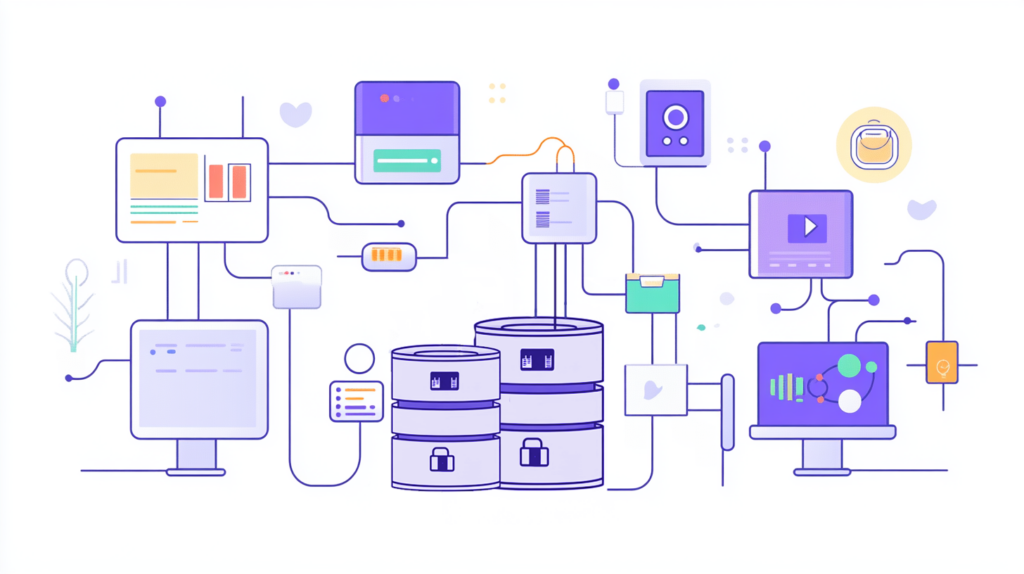Revolutionizing AEC with Unified Data Ecosystems

Ever since we were a small(er) three people company, we started an initiative that is still going strong today, having grown to 20+ people.
That initiative is our data warehouse. But, what does having a data warehouse mean?
What is a Data Ecosystem?
A data ecosystem refers to the interconnected network of data sources, technologies, and processes within an organization or across multiple entities. It encompasses the entire lifecycle of data, from its creation and collection to storage, analysis, and decision-making. Here’s a concise explanation of what a data ecosystem entails:
Components of a Data Ecosystem:
- Data Sources: These can be internal or external, structured or unstructured data. Sources include databases, IoT devices, customer interactions, social media, and more.
- Data Storage: Data needs a place to reside, such as databases, data lakes, or cloud storage solutions, where it can be accessed when required.
- Data Processing: This involves data transformation, cleaning, and preparation for analysis. Tools like ETL (Extract, Transform, Load) processes are used.
- Analytics and Machine Learning: Data is analyzed using various techniques to extract insights, make predictions, and inform decision-making.
- Data Visualization: The results of data analysis are often presented in visual formats, such as graphs or dashboards, to aid understanding.
- Data Governance: This ensures data quality, security, and compliance with regulations.
- Data Integration: Combining data from diverse sources to create a unified view is crucial for holistic insights.
Benefits of a Data Ecosystem:
A well-designed data ecosystem enables organizations to harness the power of data for informed decision-making, improved efficiency, and innovation. It supports real-time insights, data-driven strategies, and a competitive edge in today’s data-driven world.
In summary, a data ecosystem is the comprehensive framework that enables organizations to manage, analyze, and leverage data effectively, transforming it into a valuable asset that drives business success.
The Silo Problem
It’s normal for organizations to push data on different platforms every day. Specific areas and teams naturally use individual tools to accomplish their daily goals, whether marketing tracking a campaign, sales keeping tabs on customers and deals, accounting crunching numbers, or operations pushing projects forward (you get the idea). Data silos will exist, no matter how hard we try to connect these platforms.
After the digital transformations and migrations we’ve seen in the past few decades (and years), we’re continuously adding platforms for different purposes to support remote work, building digital infrastructures that allow us to collaborate. This tendency is not stopping any time soon.
Why are Data Silos Problematic?
Data silos refer to isolated collections of data within an organization that are not easily accessible or shared with other departments or teams. While they may initially appear to serve specific functions, data silos present several significant problems:
1. Inefficiency: Data silos lead to redundant efforts as different departments gather and store the same data independently. This duplication of work wastes time and resources.
2. Inaccuracies: Isolated data sources can result in inconsistencies and errors, as updates or corrections in one silo may not be reflected in others. This undermines data quality and trustworthiness.
3. Limited Insights: Data silos restrict the ability to analyze data comprehensively. To gain a holistic view, teams must navigate multiple silos, which is time-consuming and may lead to incomplete insights.
4. Hindered Collaboration: Siloed data inhibits collaboration among teams. When data is not easily shareable, cross-functional projects become challenging, slowing down decision-making and innovation.
5. Missed Opportunities: Valuable insights and opportunities hidden in one department’s data may go unnoticed by others. This lack of data sharing can hinder organizations from making informed decisions or capitalizing on emerging trends.
6. Compliance and Security Risks: Data silos can create compliance and security issues, as sensitive information may not be adequately protected or reported as required by regulations.
7. Customer Experience Impact: Silos can lead to disjointed customer experiences when different departments hold separate customer data, resulting in poor communication and customer frustration.
8. Costly Integration: When organizations finally recognize the need to break down data silos, the process of integrating disparate systems can be complex and expensive.
How Data Initiatives Help: The Data Warehouse
Rather than fighting this situation, building a data warehouse helps take advantage of it. Regardless of how distinct the platforms used in different areas of an organization may be, their data gets consumed and stored in a centralized location. Data is “potential information, analogous to potential energy: work is required to release it”, with information being “data that has been processed into a form that may be consumed by a human being”. 1
So, the first step to releasing this potential information is to have it available. A data warehouse facilitates that: data gets inserted into it through different connectors that transform it and organize it into a normalized format, with the warehouse acting as a central, cloud-based database.
So far, we have a large pool of data from different sources, centralized in a single place. But, here’s where the best part comes in: the data silos from each platform no longer constitute an issue. We can use data from a single source or mix it up to generate reports that make it easier to gather insights from it. For example, we can merge data from accounting with operations, balancing the status of the projects and how they perform financially. Or, bring sales deals and compare that to how a marketing campaign is converting, to name a few.

The warehouse constitutes a sort of “company brain” with reports acting as gauges that allow us to get the overall status of things at a glance, getting insights that otherwise, we may surely miss.
Some components of it, like Forky, are internal systems we’re developing for ourselves. Others come from third-party providers. Regardless of their origin, they all interact here.
Thoughts for the Industry
We’re a software company working in the AEC industry, and what I’ve described here is all meant at a company level. As an architect-coder (architect of actual buildings), I’d also like to mention applications to the industry, particularly in a BIM context. We provide several services in this regard, oriented at architectural/engineering studies, AEC software, or BIM production companies.
Imagine having a single place where you could manage all BIM data from different projects, along with productivity metrics from the field and the office, produced by each user and stakeholder? I think that’s a world we all aspire to in a traditionally data-siloed industry.
References
- Jeffrey Pomerantz in Metadata
Francisco Maranchello
A proactive entrepreneur at heart who constantly seeks new challenges. As an Architect who codes, I have broadened my skill set through a passion for technology and innovation. I believe technology is the future of architecture and the built world. Always learning and leveraging cutting-edge technologies to seek new answers, I bring a holistic approach when facing new challenges.
